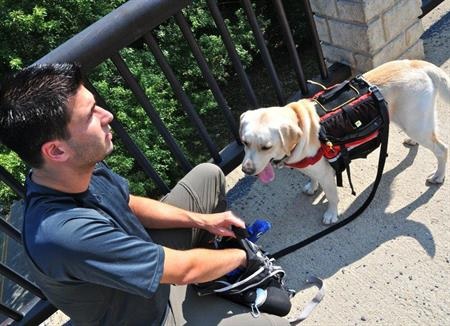 We love our dogs, and they love us. Should you hike together? If so, what common sense rules and actual regulations need to be kept in mind?
We love our dogs, and they love us. Should you hike together? If so, what common sense rules and actual regulations need to be kept in mind?
Should you hike with your dog? “Maybe” is the only accurate answer. We love many people who, for a wide variety of reasons, would not be good hiking companions. Same with dogs. The trail is physically challenging for both dogs and people. Hot weather, cold weather, and other factors can increase the challenge. Some dogs who are perfectly well-behaved at home are very territorial around other dogs and strange people. And then there are all the wonderful strange new sights and smells on the trail. I have seen a leashed dog slip the leash to chase a deer on the trail to McAfee Knob. A hiker was recently injured in Southwest Virginia when her dog decided to chase a bear and she intervened when the bear stood its ground.(Unleashed dogs are more likely to aggravate bears than leashed dogs.)
As with friends and family, just because you love to hike does not mean your dog will enjoy it. So start with shorter walks and work your way up, just as you would do with a person.
Common sense considerations. Our McAfee Knob section receives as many as 90,000 visitors per year, many of them with dogs. Lots of dogs are well-prepared and well-behaved. Here are a few suggestions based on what our volunteers have seen over the years (you can find more detailed suggestions here, here and many other places):
- Is your dog accustomed to walking the distance you will be traveling? More than one dog – some quite large – has been carried out from a day hike on the AT. Be thoughtful in choosing terrain and distances.
- Did you bring water for your dog? This is extremely important on hot days, especially for long-haired dogs. Much of the AT has no water, especially on ridgetops and scenic overlooks. Many springs dry up during the summer.
- How will your dog behave around strange people, other dogs and unusual wildlife? Some popular parts of the AT (including McAfee Knob and Tinker Cliffs) require dogs to be on leashes (see details below) and all require dogs to be under your verbal control and close to you. Be sure your dog is wearing a collar (or microchip) that will allow someone to find you if you get separated. Many of us who have hiked the entire AT have encountered dogs running loose and growling – followed by the owner who says, “S/he won’t hurt anyone.” There have been multiple dog incidents on the Trail recently. In one case, a thru hiker was bitten by an unleashed dog that belonged to people camping near a shelter near McAfee Knob. The hiker is now receiving a series of rabies vaccinations due to the dog bite. In another incident, a leashed dog attacked a hiker. To his credit, the dog’s owner paid for the hiker’s medical care and motel stay while the hiker recuperated. In 2017, a child was bitten on the face by a dog at the Dragon’s Tooth parking lot.
- How can you avoid crowds? Consider hiking at less busy times, such as on weekdays rather than weekends.
Rules and regulations. The entire Appalachian National Scenic Trail is a unit of the National Park system, with a complex set of federal, state, local and private landowners. For the RATC section of the AT, there are 2 major sets of rules, governed by the federal agency that has primary management of the trail segment – the US Forest Service and the National Park Service.
Jefferson National Forest. Most of the RATC section of the AT is in the Jefferson National Forest. Your dog needs to be under your verbal control, and the Forest Service offers more guidelines about hiking with a dog. A lot of it is common sense!
National Park Service lands. From Va 624 (first road north of Dragon’s Tooth) to Va 652 (north of Interstate 81 and US 11), the AT is on National Park Service lands with special rules. You can see details about camping and other issues on our McAfee Knob/Triple Crown page, but let’s talk about dogs! On this section, the following regulations apply:
36 CFR §2.15 – PETS (a)(2) Pets must be restrained on a leash that does not exceed six feet in length. (This is a relatively short leash. Please note that e-collars are not allowed as a replacement for a leash on the AT.)
(a)(5) Pet excrement shall be disposed of only at sanitary facilities within the park or must be buried six (6) to eight (8) inches deep at least 200 feet from any trails, overnight sites or water sources. These regulations are intended to enhance the natural experience of all visitors. Pets are natural predators and their waste can alter the behavior of wildlife and compromise the ecological health of wildlife communities.
Even the best-behaved dogs can be unpredictable when encountering new sights and smells, plus hundreds of other visitors and other dogs on an unfamiliar trail. From all the hikers and trail mantainers in RATC, thank you to the dog owners who use a leash!
